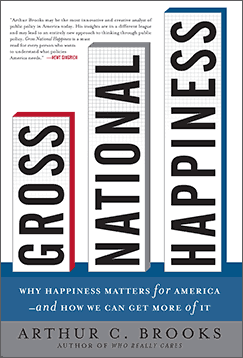
Source of book image: http://www.arthurbrooks.net/images/book-2.gif
(p. A13) In “Gross National Happiness,” Mr. Brooks has assembled an array of statistics to measure the mood of America’s citizens and to discover the reasons they feel as they do. Most often he cites polls that ask for self-described happiness levels, matching up the answers with various beliefs, habits, life choices or experiences.
And what exactly is happiness? Who knows? The term might refer joy or contentment or moral self-approval or material well-being or appetitive pleasure – or some combination of them all. Mr. Brooks is aware of the problem. He says that Potter Stewart, the Supreme Court justice, could have been describing happiness when he said, of pornography, “I know it when I see it.”
. . .
He challenges those partial to tales about long-suffering Wal-Mart workers and surly burger flippers to rethink their victimology creed. The woe is not nearly as widespread as rumored: 89% of Americans who work more than 10 hours a week are very satisfied or somewhat satisfied with their jobs while only 11% are not very satisfied or not at all satisfied. Most surprisingly, Mr. Brooks writes, there “is no difference at all in job satisfaction between those with below-average and above-average incomes.”
What really makes Americans hate their jobs is a perception that advancement is impossible. And while Mr. Brooks agrees that the nation’s income gap is growing, the national happiness level is steady. Just under one-third of American adults say that they are “very happy”; up to 15% are not too happy; and everyone else is somewhere in the middle. Those numbers have been roughly true since the early 1970s. More government spending doesn’t seem to raise happiness levels, though direct government assistance may diminish it. Charitable giving, Mr. Brooks adds, generally lifts the spirits; Americans do a lot of it.
For the full review, see:
DAVE SHIFLETT. “Bookshelf; How to Be of Good Cheer.” The Wall Street Journal (Mon., May 12, 2008): A13.
(Note: ellipsis added.)

